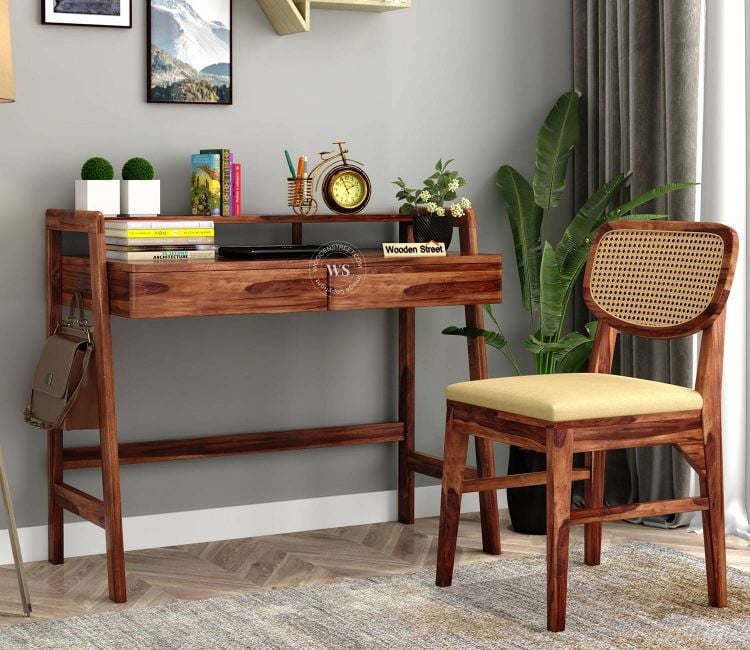In today's fast-paced and distraction-filled world, having a dedicated and well-organized study space is more important than ever. Whether you’re a student, a professional, or someone who loves reading and writing, your environment plays a crucial role in determining your productivity and focus. Among the key elements that define a good study space, the table and chair take center stage.
Let’s explore how to create your perfect study environment by choosing the right table and chair, organizing your surroundings, and maintaining a space that encourages deep focus and comfort.
Why a Dedicated Study Space Matters
Having a specific area reserved for studying or working helps your brain associate that space with productivity. It minimizes distractions and increases your ability to concentrate. This physical boundary between leisure and work makes it easier to get into a “work mode” when needed.
A study space that feels personalized and comfortable can also boost motivation and reduce procrastination. It’s not just about having a place to sit — it’s about designing a zone that supports your mental clarity and long-term focus.
Choosing the Right Location
Before diving into furniture and décor, decide where your study environment will be located. Ideally, choose a quiet spot with minimal noise and foot traffic. Natural lighting is a bonus, as it enhances mood and reduces eye strain. If natural light isn’t available, ensure you have sufficient artificial lighting that mimics daylight.
Avoid placing your study area too close to your bed or television, as these can become tempting distractions. Instead, opt for corners, spare rooms, or even unused dining areas that can be transformed into productive nooks.
The Importance of Ergonomics
Sitting for long hours requires thoughtful ergonomics. Improper seating or desk height can lead to neck pain, backaches, and fatigue. This is why investing in a comfortable, well-designed table and chair is essential.
Table Ergonomics
Your desk should be at a height where your arms rest comfortably while typing or writing. There should be ample space to hold your books, laptop, stationery, and a water bottle without making it look cluttered. Look for a surface that is smooth but not too glossy to avoid distracting reflections.
Chair Ergonomics
A good study chair should offer lower back support, adjustable height, and cushioning. Armrests and a slightly reclined back can also enhance comfort. The goal is to support your posture so that you can focus on studying without frequent adjustments or discomfort.
Organize for Efficiency
Clutter is a hidden enemy of productivity. Organizing your space can significantly boost your focus and efficiency.
Storage Solutions
Include drawers or shelves to store your books, notebooks, files, and supplies. Use organizers, trays, or small baskets to keep essentials like pens, sticky notes, and chargers within easy reach. Keeping your study surface clean and minimal helps in reducing distractions.
Cable Management
In a digital age, wires are unavoidable. Use clips or cable organizers to avoid a tangled mess under or over your desk. Wireless accessories are also great to minimize clutter.
Minimal Yet Functional Décor
Decorate your study space with functional elements like a cork board, calendar, or inspirational quotes. A small indoor plant can add a touch of nature and help purify the air. Remember, the key is to enhance, not overwhelm.
Lighting and Ambience
Lighting can make or break a study space. As mentioned, natural light is ideal, but not always available. In such cases, a good desk lamp is essential. Choose a lamp with adjustable brightness and color temperature. White or cool-toned light is best for reading and working.
Avoid harsh overhead lights that cast shadows or create glare on your screen. Instead, create a soft, ambient glow with additional sources like LED strips or warm-tone table lamps in the room.
Incorporate Technology Thoughtfully
Technology is a double-edged sword — it can enhance or distract. Use it wisely in your study space. Consider a charging station for all your gadgets, and use productivity apps or timers to keep track of your study sessions.
Avoid keeping non-essential devices like game consoles or unrelated apps nearby. If you’re easily distracted by your phone, try placing it out of arm’s reach or using a focus mode.
Create a Study Routine
Even the best study setup won’t help if you lack discipline. To make the most of your environment, establish a consistent routine. Choose a regular time for studying, and stick to it. Use techniques like the Pomodoro method (25 minutes work, 5 minutes break) to maintain focus without burnout.
Having a visual schedule or to-do list on your desk can keep you on track and give you a sense of accomplishment as you complete tasks.
Personalization is Key
Your study space should reflect your personality. Add elements that inspire you — a vision board, a few favorite books, a motivational poster, or a cozy throw blanket. The goal is to make it a space where you want to spend time.
However, balance is important. Don’t over-decorate or clutter the area. Choose colors and textures that calm your mind and promote concentration. Earth tones, light blues, and neutral shades often work well in study settings.
Conclusion: Invest in Your Focus
Creating an ideal study space is an investment in your productivity, mental well-being, and academic or professional success. The right furniture, lighting, organization, and routine can transform a corner of your home into a powerhouse of focus and creativity.
When you prioritize comfort and efficiency, even long hours of studying become less draining. A thoughtfully chosen study table and chair can be the cornerstone of this transformation — offering both support and style.
Start with what you have, gradually improve your setup, and most importantly, make it yours. Because the best study space isn’t the most expensive one — it’s the one where you feel inspired to grow.





Comments